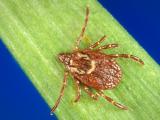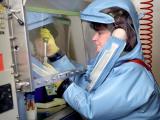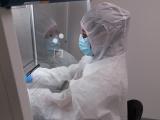Jan 27, 2005 (CIDRAP News) An investigation into how three scientists contracted tularemia from a supposedly harmless strain of bacteria appears to be pointing toward a natural source, the Boston Globe has reported.
A naturally occurring pathogenic strain of Francisella tularensis bacteria may have contaminated the growth medium used for the modified, safe bacteria that the Boston University (BU) researchers were studying, the paper's online edition said on Jan 21.
Federal disease investigators have spent the last two months trying to unravel how the three researchers became ill following exposure to a benign form of the bacteria. Investigators have largely eliminated the idea that workers at BUor at the Nebraska lab that supplied F tularensis to BUsomehow mixed the harmless and dangerous strains, said Dr. Paul Mead, head of a federal investigation, in the story. He added there was no indication of intentional contamination.
Rather, the scientists may indirectly have contracted the illness, also known as rabbit fever, from a common source: rabbits.
The University of Nebraska lab that supplied BU with its benign form of F tularensis didn't work with the dangerous type A form. But it did often use animal blood to grow its samples, the newspaper reported. Both forms were found in a vial shipped from Nebraska to the BU lab.
"But that didn't answer the question of how did it get into the original bottle," Dr. Anita Barry, Boston's director of communicable disease control, was quoted as saying.
Investigators learned that the Nebraska lab used rabbit blood from a farm in South Carolina as a growth medium.
"To make a batch of rabbit blood, it requires a good number of bunnies," Barry told the Globe. "One hypothesis is that there was an infected rabbit and when Nebraska got the rabbit blood, it would have had Type A tularemia in it that nobody knew about."
By the time the problem was identified in Boston, no blood left from that suspect batch was left in Nebraska, Barry added.
Two of the researchers fell ill in May 2004. The third became ill in September, the newspaper story said. All three recovered.
It was the first known instance of researchers at the university becoming infected with a biological agent they were studying, the paper quoted a city health official as saying in a Jan 19 story.
The incident came at a contentious time for Boston University. The school was seeking approval to create a high-biosecurity (biosafety level 4) lab, the newspaper said. Public hearings on the plan were taking place at about the time university officials reported the tularemia cases to authorities last November. A spokesman for the mayor of Boston said the cases weren't made public because tularemia is not contagious among people and because doing so could have jeopardized the investigation.
The researchers had violated lab policies requiring them to handle tularemia in an enclosed area equipped with air filters, Dr. Thomas J. Moore, acting provost of BU's medical campus, told the newspaper. However, their activities in the level-2 lab should not have caused illness.
"The deck was stacked against" the researchers "because they were working with something they had no idea they were working with," Moore said.
Despite the controversy, the city zoning commission approved the lab earlier this month, an interim step to its creation, the paper said.
Meanwhile, 60 researchers were tested for tularemia, but no additional exposures were found. The lab was closed for decontamination, the newspaper added.
The BU lab received a 5-year federal grant in 2003 to develop a vaccine for tularemia. F tularensis is one of the six pathogens the government believes terrorists are most likely to use as a weapon. Both the United States and the former Soviet Union developed the agent as a biological weapon during the Cold War.
See also:
CIDRAP overview of tularemia
http://www.cidrap.umn.edu/cidrap/content/bt/tularemia/biofacts/tularemiafactsheet.html#top

















